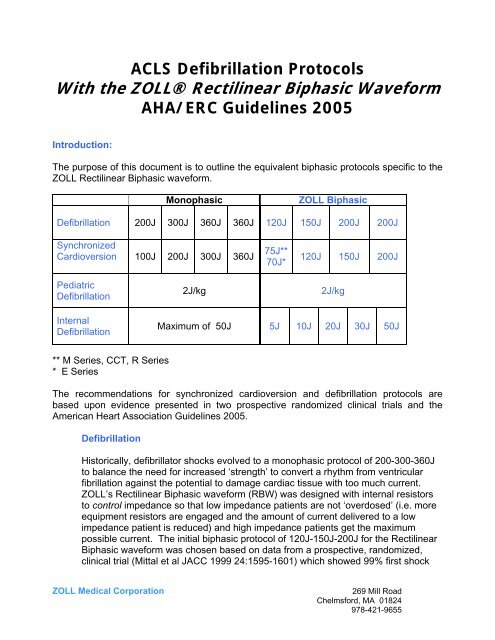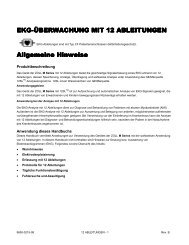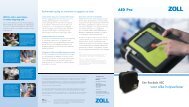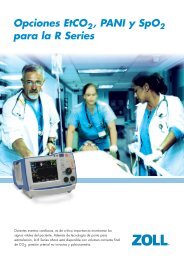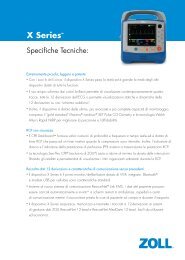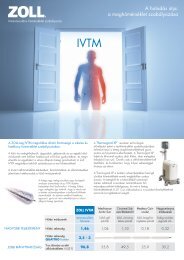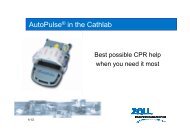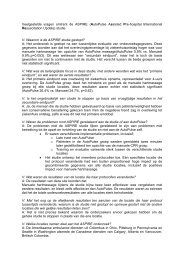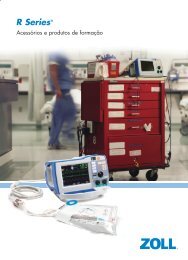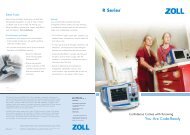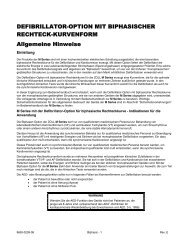ACLS Defibrillation Protocols - ZOLL Medical Corporation
ACLS Defibrillation Protocols - ZOLL Medical Corporation
ACLS Defibrillation Protocols - ZOLL Medical Corporation
You also want an ePaper? Increase the reach of your titles
YUMPU automatically turns print PDFs into web optimized ePapers that Google loves.
<strong>ACLS</strong> <strong>Defibrillation</strong> <strong>Protocols</strong><br />
With the <strong>ZOLL</strong>® Rectilinear Biphasic Waveform<br />
AHA/ERC Guidelines 2005<br />
Introduction:<br />
The purpose of this document is to outline the equivalent biphasic protocols specific to the<br />
<strong>ZOLL</strong> Rectilinear Biphasic waveform.<br />
<strong>Defibrillation</strong><br />
Synchronized<br />
Cardioversion<br />
Pediatric<br />
<strong>Defibrillation</strong><br />
Internal<br />
<strong>Defibrillation</strong><br />
** M Series, CCT, R Series<br />
* E Series<br />
Monophasic <strong>ZOLL</strong> Biphasic<br />
200J 300J 360J 360J 120J 150J 200J 200J<br />
100J 200J 300J 360J 75J**<br />
70J*<br />
2J/kg 2J/kg<br />
120J 150J 200J<br />
Maximum of 50J 5J 10J 20J 30J 50J<br />
The recommendations for synchronized cardioversion and defibrillation protocols are<br />
based upon evidence presented in two prospective randomized clinical trials and the<br />
American Heart Association Guidelines 2005.<br />
<strong>Defibrillation</strong><br />
Historically, defibrillator shocks evolved to a monophasic protocol of 200-300-360J<br />
to balance the need for increased ‘strength’ to convert a rhythm from ventricular<br />
fibrillation against the potential to damage cardiac tissue with too much current.<br />
<strong>ZOLL</strong>’s Rectilinear Biphasic waveform (RBW) was designed with internal resistors<br />
to control impedance so that low impedance patients are not ‘overdosed’ (i.e. more<br />
equipment resistors are engaged and the amount of current delivered to a low<br />
impedance patient is reduced) and high impedance patients get the maximum<br />
possible current. The initial biphasic protocol of 120J-150J-200J for the Rectilinear<br />
Biphasic waveform was chosen based on data from a prospective, randomized,<br />
clinical trial (Mittal et al JACC 1999 24:1595-1601) which showed 99% first shock<br />
<strong>ZOLL</strong> <strong>Medical</strong> <strong>Corporation</strong> 269 Mill Road<br />
Chelmsford, MA 01824<br />
978-421-9655
efficacy at 120J, and 100% efficacy at 150J. Based on this data, the 200J shock<br />
represents a safety margin.<br />
Recent recommendations with ERC and AHA Guidelines suggest that rescue<br />
sequences with defibrillation move away from the concept of three stacked shocks<br />
to a sequence of single shocks with CPR between each shock. The logic for this<br />
recommendation is that stacked shocks result in too much ‘hands off’ time, during<br />
which chest compressions are not performed. Recent experimental data suggests<br />
that maximizing the amount of time compressions are performed along with quality<br />
of compressions will have the most significant impact on survival. The new<br />
Guidelines do not alter the recommended defibrillation protocol for the <strong>ZOLL</strong><br />
Rectilinear Biphasic waveform. In fact, the efficacy of the <strong>ZOLL</strong> RBW is specifically<br />
incorporated by reference.<br />
Synchronized Cardioversion<br />
In a randomized multi-center trial 1 , the data demonstrated superior results using the<br />
<strong>ZOLL</strong> Rectilinear Biphasic waveform as compared to the monophasic waveform for<br />
both first shock and cumulative efficacy. There was a significant difference<br />
between the first shock efficacy of biphasic shocks at 70J of 68% and that of<br />
monophasic shocks at 100J of 21% (p=0.0001, 95% confidence interval of the<br />
difference of 34.1% to 60.7%). The results from this clinical trial therefore provide<br />
evidence to use 70J-120J-150J-200J for E Series and 75J-120J-150J-200J as the<br />
recommended biphasic equivalent for any synchronized cardioversion procedure<br />
using the <strong>ZOLL</strong> Rectilinear Biphasic waveform. Following the publication of this<br />
article, additional abstracts have also been presented showing statistically<br />
significant improvement over monophasic with energy settings as low as 5J with the<br />
2, 3, 4<br />
<strong>ZOLL</strong> Rectilinear Biphasic waveform<br />
Pediatric <strong>Defibrillation</strong><br />
The <strong>ZOLL</strong> Rectilinear Biphasic waveform has also been approved by the FDA for use in<br />
pediatric patients and for internal defibrillation. <strong>Defibrillation</strong> protocols for these uses are<br />
based on observational studies and animal testing. Results are summarized below.<br />
FDA approval for the use of <strong>ZOLL</strong>’s RBW technology on pediatrics was based on the<br />
results from A Comparative Biphasic <strong>Defibrillation</strong> Study for Pediatric Dosing Levels Using<br />
a Porcine Model. This study demonstrates the safety and efficacy of this waveform on<br />
pediatric patients, and supports a defibrillation protocol of 2J/kg. Although this is the same<br />
protocol as used with monophasic waveforms, pediatric patients will benefit from a<br />
reduced possibility of myocardial dysfunction associated with the use of biphasic<br />
waveforms, which deliver less peak current than monophasic waveforms.<br />
<strong>ZOLL</strong> <strong>Medical</strong> <strong>Corporation</strong> 269 Mill Road<br />
Chelmsford, MA 01824<br />
978-421-9655
Internal <strong>Defibrillation</strong><br />
The use of <strong>ZOLL</strong>’s RBW technology for internal defibrillation has also been cleared by the<br />
FDA. A shock sequence of 5J, 10J, 20J, 30J and 50J was used in an observational study.<br />
First shock success rate was 90% for 5J. In addition to the clinical data, customers should<br />
also be made aware that anecdotal stories suggest that internal shocks delivered with the<br />
<strong>ZOLL</strong> RBW do not cause as much movement when the shock is delivered as was seen<br />
with monophasic waveforms. This should not be confused with failure to deliver the shock.<br />
If the heart does not restart after the initial shock, additional shocks with incremental<br />
energy levels should be delivered until conversion is achieved.<br />
Other Arrhythmias<br />
The use of the <strong>ZOLL</strong> Rectilinear Biphasic waveform has not been studied in randomized<br />
prospective clinical trials for all types of arrhythmias covered by <strong>ACLS</strong> algorithms.<br />
Nonetheless, the following factors support using the biphasic energy equivalents for either<br />
Synchronized Cardioversion or <strong>Defibrillation</strong> as required:<br />
1. All <strong>ACLS</strong> algorithms which refer to electrical conversion specify either<br />
synchronized cardioversion or defibrillation, depending on the specific<br />
rhythm, and evidence for the <strong>ZOLL</strong> Rectilinear Biphasic waveform exists for<br />
both synchronized cardioversion and defibrillation.<br />
2. The <strong>ZOLL</strong> Rectilinear Biphasic waveform has been documented as clinically<br />
equivalent or superior (in accordance with the AHA recommendation that the<br />
upper boundary of the 90% confidence interval of the difference between<br />
standard and alternative waveforms must be
Observational Study for Direct Ventricular <strong>Defibrillation</strong> during Open Heart Surgery<br />
Overview: A clinical study was performed to demonstrate the safety and efficacy of the RLB waveform<br />
when the waveform was applied directly to hearts in ventricular fibrillation (VF) during open heart surgery.<br />
There were 20 patients enrolled in the study. All patients were classified as NYHA class III, had significant<br />
coronary artery disease (CAD), and underwent coronary artery bypass graft (CABG) surgery as the method<br />
of treatment. One or more RLB waveform shocks were applied directly to the heart if VF occurred. The RLB<br />
shock sequence was 5 J, 10 J, 20 J, 30 J, and 50 J. Shock energies were applied in sequence until<br />
defibrillation occurred.<br />
Results: All patients were successfully defibrillated with a selected shock energy less than or equal to 20 J.<br />
The first shock defibrillation success rate at the initial energy selection of 5 J was 90% (18/20) compared to<br />
the reported cumulative success rate for the BTE waveform of 50% (25/50) at 5 J 1 . The threshold energy<br />
was 6.0 ± 3.5 J, the cumulative energy was 7.0 ± 7.0 J, and the average number of shocks was 1.2 ± 0.5<br />
shocks. No patient experienced abnormal left ventricular wall motion at any time and all patients were<br />
defibrillated to normal sinus rhythm.<br />
1 Schwarz B, Bowdle TA, Jett GK, Mair P, Lindher KH, Aldea GS, Lazzara RG, O'Grady SG, Schmitt PW, Walker RG, Chapman FW Tacker WA,<br />
Biphasic shocks compared with monophasic damped sine wave shocks for direct ventricular defibrillation during open heart surgery, Anesthesiology<br />
2003; 98: 1063.<br />
<strong>ZOLL</strong> <strong>Medical</strong> <strong>Corporation</strong> 269 Mill Road<br />
Chelmsford, MA 01824<br />
978-421-9655
A Comparative Biphasic <strong>Defibrillation</strong> Study For Pediatric Dosing Levels Using A Porcine Model<br />
Overview. The safety and efficacy of the <strong>ZOLL</strong> Rectilinear Biphasic(RLB) waveform was evaluated as the<br />
defibrillation shock in an external defibrillator (<strong>ZOLL</strong> <strong>Medical</strong> M-Series) to defibrillate young children « 8<br />
years old) presenting in ventricular fibrillation(VF)or hemodynamically unstable ventricular tachyarrhythmias<br />
(VT). The study compared the <strong>ZOLL</strong> <strong>Medical</strong> rectilinear biphasic (RLB) waveform with a biphasic truncated<br />
exponential (BTE)waveform.1-3 The study, using an immature porcine model, was a prospective,<br />
randomized, controlled, cross-over design to determine the dose response curves for the RlB and BTE<br />
defibrillation waveforms. A weight range from 4 to 24 Kg for an animal represented a pediatric patient. The<br />
weight ranging from 4 to 8 Kg represented a patient less than 1 year old (infant subgroup), and the weight<br />
range from 16 to 24 Kg represented a pediatric patient between the ages of 2 and 8 years (young children<br />
subgroup).<br />
Objectives. The primary objective of the study was to demonstrate that an RlB shock has superior<br />
performance with equivalent safety when compared to a BTE shock in a porcine model for young children.<br />
An additional objective was to compare the defibrillation thresholds at a 50% (D50) and 90% (D90)<br />
probability of success for the external RLB and BTE defibrillation waveforms.<br />
Intended Use. The RLB waveform will be used as the defibrillation shock in external defibrillators<br />
manufactured by <strong>ZOLL</strong> <strong>Medical</strong> <strong>Corporation</strong> to defibrillate young children « 8 years old) presenting with VF<br />
or VT. The RLB waveform defibrillator will be used to defibrillate these children with appropriate dosing<br />
levels, as determined from previous work and the present study.<br />
<strong>ZOLL</strong> <strong>Medical</strong> <strong>Corporation</strong> 269 Mill Road<br />
Chelmsford, MA 01824<br />
978-421-9655
References<br />
1 Mittal et al Transthoracic cardioversion of atrial fibrillation. Circulation. 2000;101:1282-1287<br />
2 Niebauer et al Cardioversion thresholds of atrial fibrillation and atrial flutter using an external biphasic<br />
waveform defibrillator. Presented at NASPE 2000 (abstract)<br />
3 Friedman et al Role of ibutilide and biphasic waveforms for cardioversion of atrial fibrillation in routine<br />
clinical practice. PACE 2002; 24:634 (abstract)<br />
4 Schute el al. Rectilinear biphasic rather than monophasic waveforms for Transthoracic cardioversion of<br />
patients with rheumatic heart disease and longstanding atrial fibrillation after corrective mitral valve<br />
procedures. Journal of the American College of Cardiology. 2002;39:429A (abstract)<br />
5 Kerber at al, AHA Scientific Statement. Circulation 1997;95:1677-1682.<br />
<strong>ZOLL</strong> <strong>Medical</strong> <strong>Corporation</strong> 269 Mill Road<br />
Chelmsford, MA 01824<br />
978-421-9655


